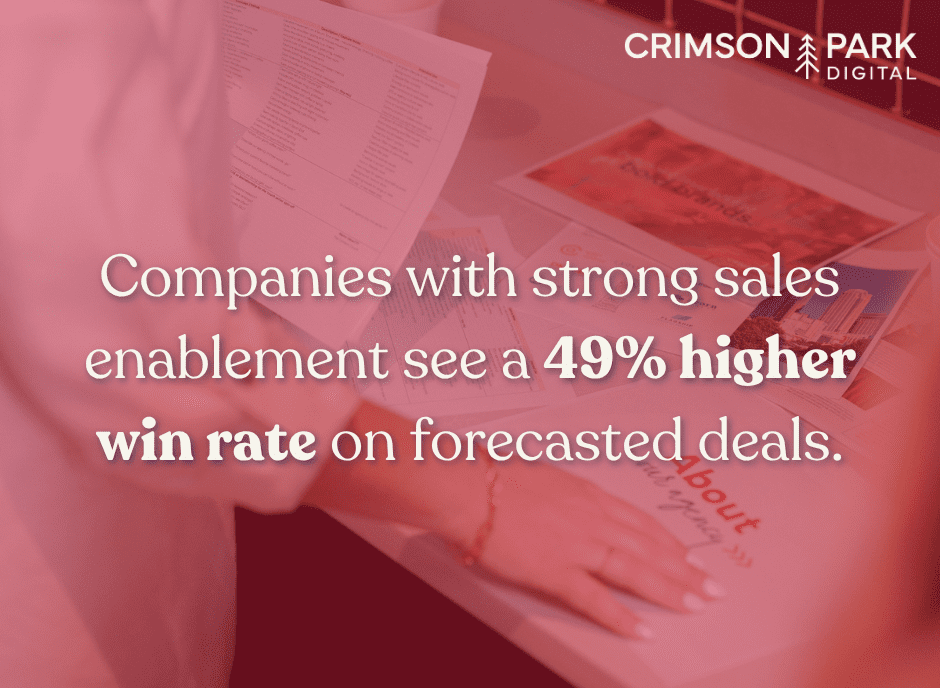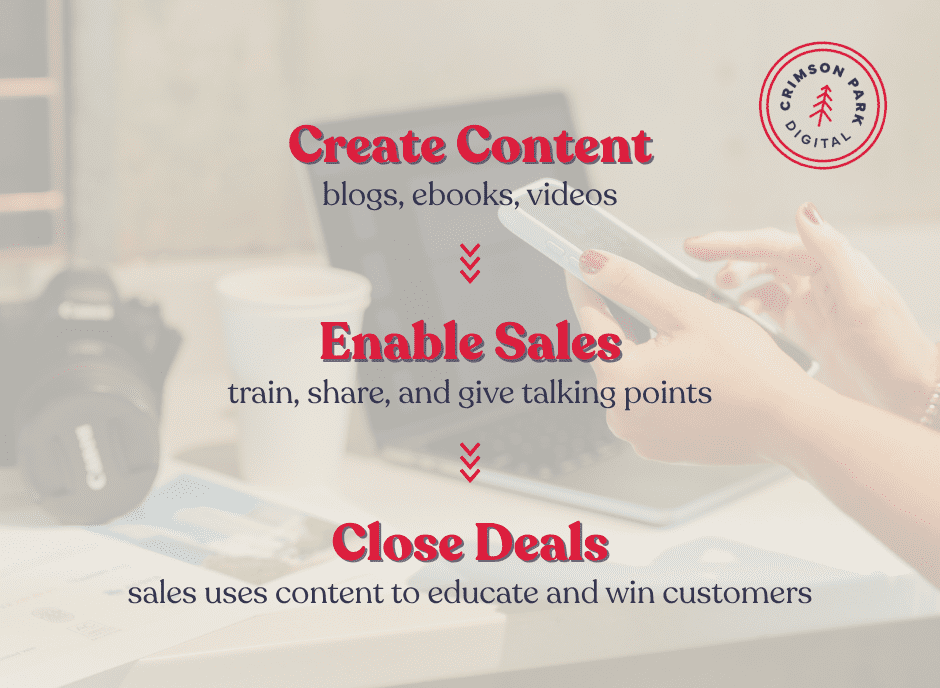Let’s Start with the Basics: What Is Sales Enablement, Really?
Sales enablement is how marketing helps sales teams effectively utilize content to close deals. It’s about ensuring your team isn’t just creating blogs, white papers, or videos that live and die on your website, but instead providing your sales reps with the right tools, training, and talking points to put that content to work.
Think of it like this: if your marketing team builds the stage, sales enablement gives the sales team a way to perform on it.
It’s not just about “handing over” content. It’s about:
- Making sure your sales team knows what exists and where to find it
- Helping them understand how and when to use it in conversations
- Creating materials that actually address what buyers are asking about
- Encouraging reps to become active distributors of your content
When that synergy clicks, deals close faster, relationships deepen, and suddenly your content isn’t just creating awareness, it’s driving revenue.

The Common Disconnect: Where Sales Enablement Falls Apart
Here’s the tricky part: most teams don’t intentionally skip sales enablement. It just falls through the cracks.
We often see this scenario when working with growing companies: the marketing team is sprinting to publish content, and the sales team is sprinting to hit quota. Somewhere in the middle, alignment gets lost.
Here are the top reasons why content is falling through the cracks:
1. Nobody owns it.
Sales enablement floats in that awkward middle space between marketing and sales. If it’s not clearly owned, it doesn’t happen. Ideally, marketing should take the lead here, creating a consistent process to loop sales into the content strategy, before, during, and after creation.
2. Sales assumes content isn’t for them.
Some sales reps see content as a “marketing thing,” rather than a sales tool. But the truth is, the most successful reps use content every day to educate buyers, handle objections, and prove value. The key is showing them how powerful it can be when used intentionally.
3. Sales doesn’t like the content.
This one stings a little, but can happen. If your sales team isn’t using what you’re creating, it might be because they weren’t part of the process. They’re the ones hearing customer objections and pain points in real-time, so involving them in brainstorming and planning ensures the final product actually solves problems they face on calls.
How to Build Sales Enablement into Your Content Program
Let’s get practical. You don’t need a fancy new tech stack or a total process overhaul, just some structure and collaboration.
Here’s how to start:
1. Make content discoverable.
If your team can’t easily find content, they won’t use it. Create a shared library (even a simple Google Drive or Notion database) where content is tagged, categorized, and searchable. Label each piece by use case, audience, and funnel stage so it’s easy to know when to share it.
2. Keep communication open.
When new content goes live, don’t just drop a link in Slack and hope for the best. Give context: who it’s for, what pain points it addresses, and how it can help in conversations. A short Loom video or quick huddle goes a long way here.
3. Train your team to use content strategically.
Help your sales team understand how to naturally weave content into their outreach. Whether that’s sending a case study after a discovery call or linking a blog post that answers a prospect’s concern, it’s all about timing and relevance.
4. Gather feedback and close the loop.
Ask your reps what’s resonating. Which pieces are helping close deals? Which ones fall flat? That insight should directly inform your next round of content creation.
Why Sales Enablement Matters More Than Ever
Today’s buyers are savvy. They’ve done their research before ever talking to a sales representative. That means your content is often their first interaction with your brand, and if your sales team doesn’t know what they’ve already seen or read, the conversation can fall flat.
Sales enablement bridges that gap. It helps reps meet prospects where they are in their journey and continue the conversation seamlessly.
And the results speak for themselves: companies with strong sales enablement strategies see higher win rates, stronger customer relationships, and higher quota attainment. That’s not fluff, it’s the outcome of teams that work together instead of in silos.
When to Bring in the Experts
If this all sounds like a lot to juggle, that’s because it is. Building a sales enablement program that actually sticks takes time, coordination, and consistency and honestly, most marketing teams already have a full plate.
That’s where an agency partner like Crimson Park Digital can step in. We help bridge the gap between marketing and sales through data-driven strategy, content that actually converts, and systems that make collaboration easy.
You don’t have to do it all in-house. You just need the right partner to ensure your content doesn’t stop at “published”; it gets used.
Ready to turn your content into a true sales tool?
Crimson Park Digital can step in as an extension of your team, helping you build a full marketing and sales strategy that actually drives revenue.
If you just need content that hits the ground running, Crimson Park Content Studio creates high-quality, strategy-informed pieces your sales team will actually use to close more deals. Reach out today!



